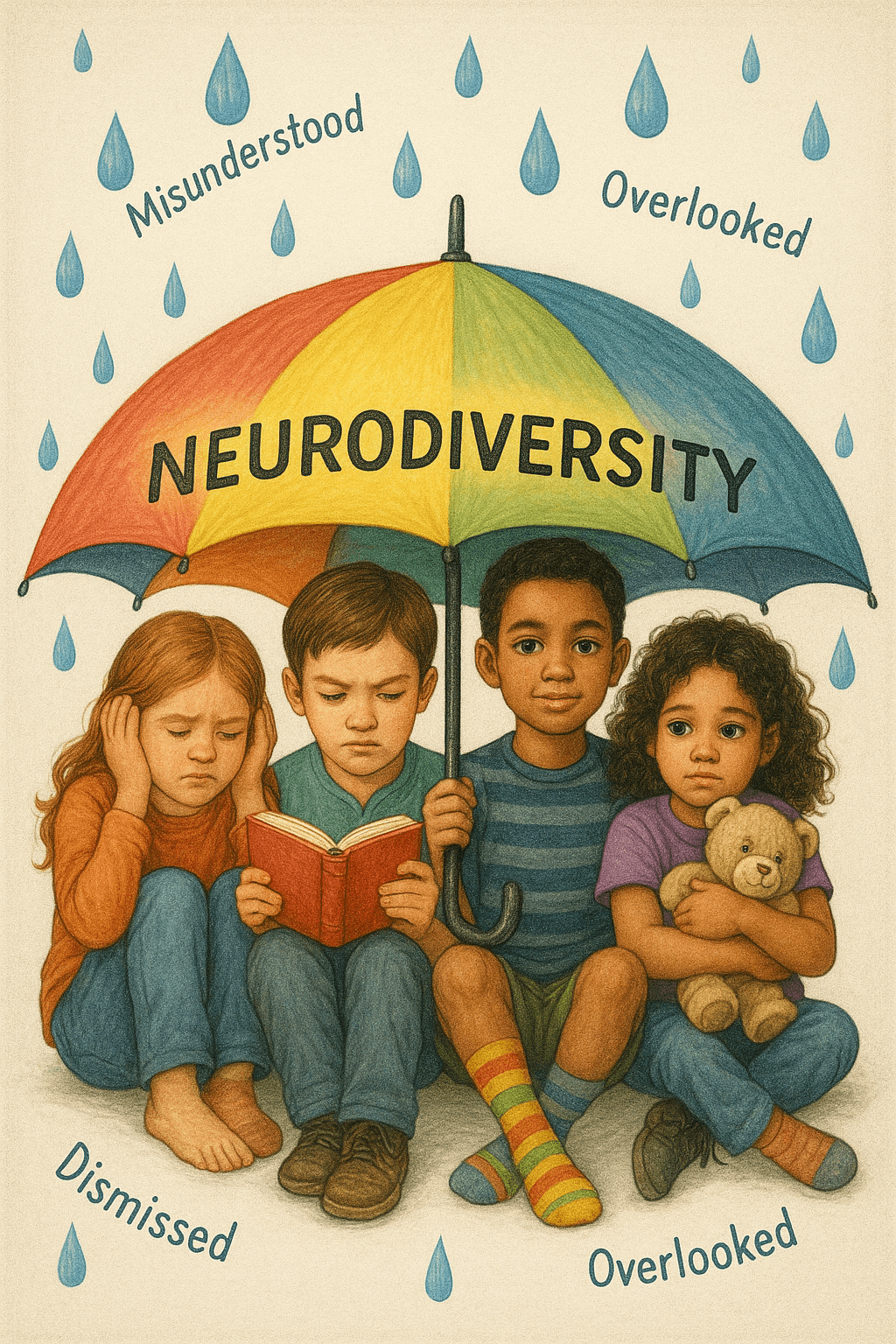When most people hear “neurodiversity,” their minds jump straight to autism or ADHD – and then stop there. But the neurodivergent umbrella is much broader (and more colourful) than that. There’s a whole constellation of lesser-known conditions, like ARFID, encopresis, and even premature thelarche, that can quietly shape a child’s experience without ever making it into mainstream conversations.
I’m writing this not to overwhelm, but to open up the lens. To help parents, educators, and ND folks themselves spot the overlooked patterns and say, “Oh wait… that’s a thing?” Because sometimes, understanding starts with simply having the language for what’s always been there.
This isn’t a diagnostic guide. It’s a reality check. And a gentle nudge to look beyond the obvious, so no child gets left behind because they didn’t fit a textbook definition.
Neurodevelopmental Conditions
These conditions typically manifest during early development and affect cognitive, emotional, and social functioning.
- Autism Spectrum Disorder (ASD): A developmental condition characterized by differences in social interaction, communication, and behavior.
- Attention-Deficit/Hyperactivity Disorder (ADHD): Marked by persistent inattention, hyperactivity, or impulsivity that interferes with daily life.
- Tourette Syndrome: A neurological condition characterized by involuntary and repeated movements and sounds.
- Dyslexia: A learning difference that impacts reading and language processing.
- Dyscalculia: Difficulty with understanding and processing numerical information.
- Dysgraphia: Difficulty with writing, affecting handwriting, spelling, and organizing thoughts on paper.
- Dyspraxia (Developmental Coordination Disorder): Affects physical coordination, leading to clumsiness and difficulty with motor tasks.
- Auditory Processing Disorder (APD): Affects the ability to understand auditory information, despite normal hearing.
Genetic and Chromosomal Conditions
These are inherited or result from chromosomal anomalies, often present from birth.
- Down Syndrome: Caused by an extra chromosome 21, leading to developmental and intellectual delays.
- Fragile X Syndrome: A genetic condition causing intellectual disability, behavioral and learning challenges.
- Williams Syndrome: Characterized by medical problems, including cardiovascular disease, developmental delays, and learning challenges.
- Prader-Willi Syndrome: A genetic disorder causing obesity, intellectual disability, and short stature.
- DiGeorge Syndrome (22q11.2 deletion syndrome): Leads to poor development of several body systems.
Acquired Neurodivergent Conditions
These develop due to injury, illness, or environmental factors after birth.
- Traumatic Brain Injury (TBI): Brain dysfunction caused by an external force, leading to cognitive and emotional challenges.
- Stroke-related Cognitive Changes: Post-stroke impairments affecting memory, attention, and executive functions.
- Long COVID Cognitive Effects: Persistent cognitive symptoms following COVID-19 infection, such as brain fog and memory issues.
- Epilepsy: A neurological disorder marked by recurrent seizures, which can impact cognitive functions.
- Multiple Sclerosis (MS) Cognitive Effects: MS can lead to cognitive impairments, including problems with memory and concentration.
- Parkinson’s Disease: A progressive nervous system disorder affecting movement and potentially leading to cognitive decline.
Psychiatric and Mental Health Conditions
While traditionally viewed separately, some mental health conditions are included in discussions of neurodiversity due to their impact on cognition and behavior.
- Bipolar Disorder: Characterized by extreme mood swings, including emotional highs (mania) and lows (depression).
- Obsessive-Compulsive Disorder (OCD): Involves unwanted recurring thoughts and repetitive behaviors.
- Borderline Personality Disorder (BPD): Affects mood and how a person interacts with others, leading to instability in relationships and self-image.
- Anxiety Disorders: Encompass various conditions characterized by excessive fear or worry.
- Depression: A mood disorder causing persistent feelings of sadness and loss of interest.
- Post-Traumatic Stress Disorder (PTSD): Triggered by experiencing or witnessing a traumatic event, leading to flashbacks and severe anxiety.
- Schizophrenia: A severe mental disorder affecting how a person thinks, feels, and behaves, often including hallucinations or delusions.
Other Neurological Conditions
These conditions affect the nervous system and can influence cognitive and behavioral functions.
- Tourette Syndrome: Characterized by repetitive, involuntary movements and vocalizations called tics.
- Synesthesia: A condition where stimulation of one sensory pathway leads to automatic, involuntary experiences in a second sensory pathway.
- Sensory Processing Disorder: Difficulty in processing and responding to sensory information, leading to over- or under-responsiveness to stimuli.
- Nonverbal Learning Disorder (NVLD): Characterized by strong verbal skills but difficulties with visual-spatial, motor, and social skills.
Lesser-Known Neurodivergent Conditions in Children
1. Premature Thelarche
- Overview: Early breast development in girls under 8, without other signs of puberty.
- Neurodivergent Link: While not directly linked, it’s important to differentiate from precocious puberty, which can co-occur with neurodevelopmental disorders.
2. Encopresis
- Overview: Involuntary defecation in children over 4, often due to chronic constipation.
- Neurodivergent Link: More common in children with developmental disorders, possibly due to sensory processing issues or difficulties with toilet training.
3. Avoidant/Restrictive Food Intake Disorder (ARFID)
- Overview: Extreme avoidance of certain foods due to sensory sensitivities or fear of choking.
- Neurodivergent Link: Common in children with autism or ADHD due to heightened sensory sensitivities.
4. Pathological Demand Avoidance (PDA)
- Overview: Extreme avoidance of everyday demands and expectations, often accompanied by anxiety.
- Neurodivergent Link: Considered a profile within the autism spectrum, though not officially recognized in diagnostic manuals.
5. Developmental Coordination Disorder (Dyspraxia)
- Overview: Affects physical coordination, leading to clumsiness and difficulties with tasks like writing or dressing.
- Neurodivergent Link: Often co-occurs with ADHD and autism.
6. Sensory Processing Disorder (SPD)
- Overview: Difficulties in processing sensory information, leading to over- or under-sensitivity to stimuli.
- Neurodivergent Link: Common in children with autism and ADHD.
7. Nonverbal Learning Disorder (NVLD)
- Overview: Strong verbal skills but challenges with visual-spatial tasks, motor coordination, and social skills.
- Neurodivergent Link: Distinct from autism but shares overlapping features.
8. Selective Mutism
- Overview: An anxiety disorder where a child is unable to speak in certain social situations despite speaking comfortably in others.
- Neurodivergent Link: Can co-occur with autism and social anxiety disorders.
9. Hyperlexia
- Overview: Early ability to read beyond one’s age but with difficulties in comprehension and social communication.
- Neurodivergent Link: Often associated with autism.
10. Tic Disorders (including Tourette Syndrome)
- Overview: Involuntary, repetitive movements or vocalizations.
- Neurodivergent Link: Frequently co-occurs with ADHD and OCD.
Note: This list is not exhaustive, and the presentation of these conditions can vary widely among individuals. Early assessment and intervention can make a significant difference in managing these conditions effectively.




